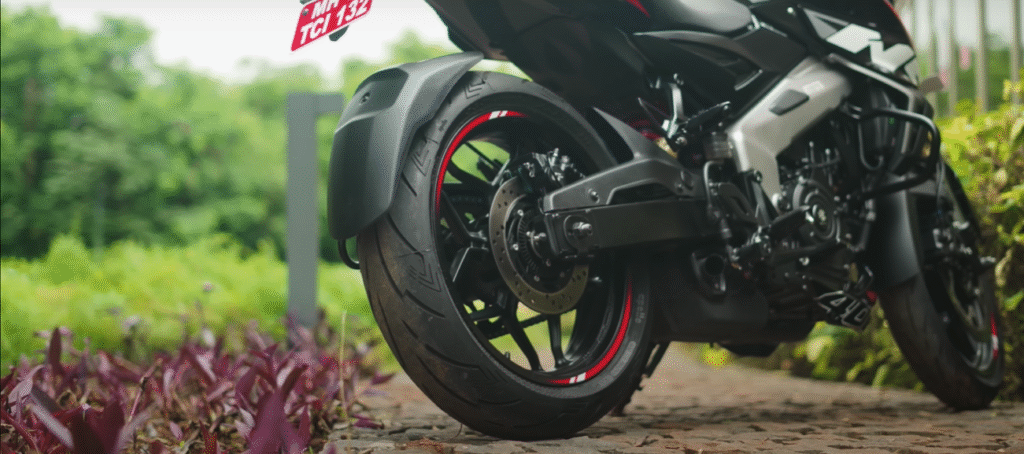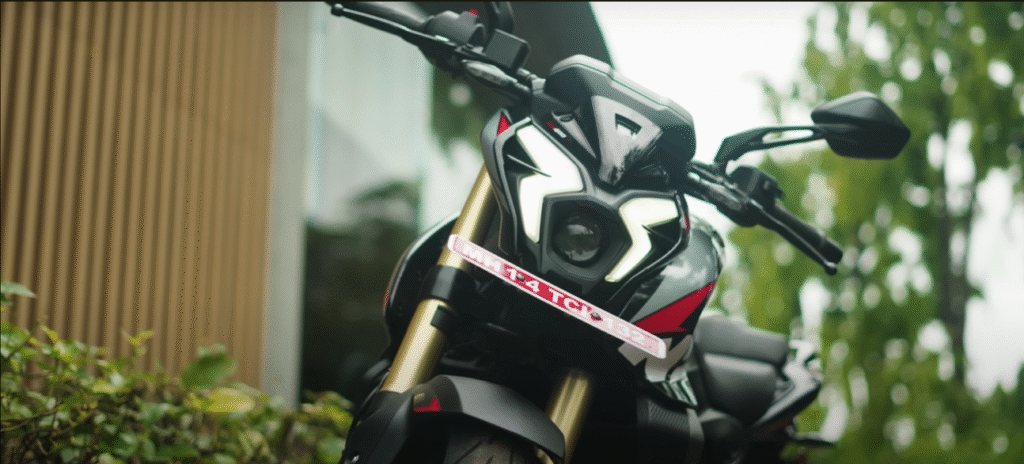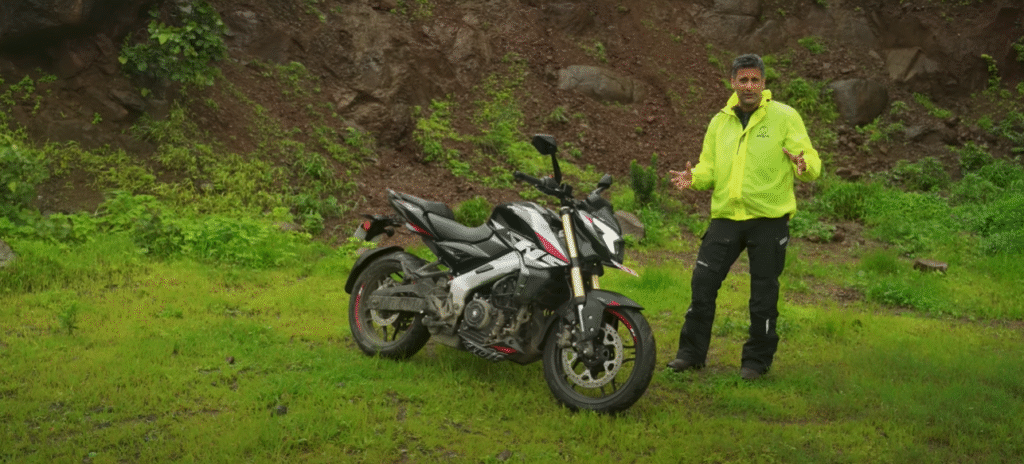In the Indian motorcycle market, the name ‘Pulsar’ isn’t just a brand; it’s a symbol of identity, representing performance, style, and value. And now, Bajaj has returned with its biggest and most ambitious offering yet to elevate this legacy to a new level: the 2025 Bajaj Pulsar NS400Z.
At first glance, it might look identical to its predecessor, even in terms of colorways. But, as is often the case, the real story lies beneath the surface. Bajaj has made several significant changes to this new NS400Z, making it not just an update, but a ‘real deal.’ These changes are directly based on feedback received about the previous model, making it the most complete package in the Pulsar lineup to date.
Do these changes translate as impressively on the road as they do on paper? Is the NS400Z finally the ‘Pulsar’ we’ve all been waiting for?
Let’s take an in-depth look at every aspect of this new and improved 2025 Bajaj Pulsar NS400Z!
Design and Aesthetics: Familiar Yet Refined
The design of the 2025 Bajaj Pulsar NS400Z closely resembles its predecessor, retaining the signature streetfighter look of the Pulsar NS series. It features the same aggressive stance, muscular fuel tank, and split-seat design. However, despite the ‘same appearance,’ Bajaj has implemented subtle yet significant refinements that enhance the bike’s overall aesthetics and functionality.



It is expected to utilize LED lighting (headlight, taillight, and turn indicators), which will not only provide better visibility but also give the bike a premium and modern look. The overall build quality will be robust and durable, consistent with Bajaj’s standards, with a generous use of metal components, giving it a premium and solid feel.
This design is well-suited for agile urban commuting and stable highway rides, making the NS400Z a versatile package.
Engine and Performance: A Powerful 43 PS Heartbeat
The most significant and welcome change in the 2025 Pulsar NS400Z is its new, more powerful engine. It now produces 43 PS of power instead of 40 PS from the previous iteration. This 3 PS increase might seem minor, but Bajaj has made substantial changes to achieve it, including improvements to the intake duct after switching to a forged piston.
This engine now feels considerably stronger in the higher revs. The rev ceiling has been increased by approximately 1,000 RPM, allowing the full 43 PS of power to be delivered at 10,600 RPM. This means that when you open the throttle, the bike packs a tremendous punch at higher speeds. Below 5,000 RPM, it feels quite similar to the older bike, but it truly comes alive around 7,000 RPM.
The engine’s refinement is also impressive. Despite the increase in power and the punchiness of the engine, vibrations (buzz) at the handlebar and foot pegs remain quite minimal. It provides just the right amount of ‘buzz’ to keep you engaged, but it never gets in your way, ensuring comfort even on longer rides.
Ride and Handling: A Balance of Stability and Agility
The NS400Z’s ride and handling experience offers an interesting balance between urban agility and highway stability. It features a wheelbase that is almost 20 mm shorter than the NS200, which theoretically makes it more nimble, especially in city traffic.
However, this shorter wheelbase might make the bike feel slightly less stable at higher speeds or when encountering bumps. Nevertheless, overall, the bike feels quite stable, especially with the new tire upgrades. It allows you to lean into corners with confidence and handle various road conditions.
Brakes and Tires: Confident Stopping Power
Bajaj has made significant improvements to the braking and tires in the 2025 NS400Z, which was a major shortcoming in the previous generation. It now features sintered brake pads, which provide superior stopping power and feedback. This was a much-needed upgrade that enhances the bike’s safety and rider confidence.
To effectively put that stopping power down on the road, Bajaj has also upgraded the tires. It now runs on Apollo Alpha H1 radial tires at both the front and rear. These tires offer significantly more grip compared to the previous generation’s tires. At the rear, there’s a slightly wider 150-section tire, which helps in keeping the motorcycle more stable, especially considering its shorter wheelbase.
However, in wet conditions, the Apollo H1s might not inspire the same level of confidence as the Protorq Extremes, particularly when leaning the bike into a corner, as they lack a bit of the feedback that the Protorqs had. Nevertheless, overall, they are still a huge step forward compared to the original tires and provide much more confidence even in adverse conditions.
Features and Technology: The First Pulsar with a Quick Shifter
Another major highlight of the 2025 Bajaj Pulsar NS400Z is its bidirectional quick shifter – this is the first Pulsar ever to get this feature! This quick shifter does not use additional sensors like the systems found on KTMs. Instead, Bajaj has worked closely with Bosch to enable it to work solely with the internal gear shift sensor, sending signals to the ECU whenever the sensor detects that the rider wants to make a change.
This system, though not considered the most accurate, works surprisingly well. The blipper (for downshifts) is much smoother than the quick shifter (for upshifts). The quick shifter requires a bit more effort to slot into place, but it works particularly well in the higher revs. You also don’t need to be riding at a certain RPM or be at full throttle for the quick shifter to work, which adds to its versatility.
However, the only gripe with this system is that it only works in Sport mode. This is disappointing because Road mode offers a calmer and more tractable throttle response for city commuting. Riders would certainly prefer to use the bidirectional quick shifter in Road mode as well, as it eliminates the need to use the clutch, especially in traffic. Hopefully, Bajaj will look into this and introduce it in other modes via a software update.
Ergonomics and Comfort: Comfort with Engagement
The ergonomics of the Pulsar NS400Z provide a sporty yet comfortable riding position. Due to the engine’s refinement, vibrations at the handlebar and foot pegs are minimal. It provides just the right amount of ‘buzz’ to keep you engaged, but it never becomes intrusive. This ensures comfort for both urban commuting and medium-distance rides.
Safety Features: A Confident Ride
With significant upgrades to braking and tires, the 2025 Pulsar NS400Z offers a confident ride. The combination of sintered pads and better-gripping radial tires ensures you have ample stopping power when needed. Dual-channel ABS (Anti-lock Braking System) is also expected to be available as standard, enhancing stability and control in emergency braking situations.
Key Specifications (Estimated)
| Feature | 2025 Bajaj Pulsar NS400Z |
|---|---|
| Engine | 450cc, Liquid-Cooled, Single-Cylinder |
| Max Power | 43 PS |
| Max Torque | (Information not available, but expected to be improved) |
| Gearbox | 6-Speed |
| Quick Shifter | Bidirectional (Sport mode only) |
| Brakes | Sintered Pads (Front and Rear) |
| Tires | Apollo Alpha H1 Radial (Front: 110/70 R17, Rear: 150/60 R17) |
| Wheelbase | Approx. 20 mm shorter than NS200 |
| Estimated Price Increase | ₹8,000 (from previous generation) |
| Total Estimated Price | (Previous generation price + ₹8,000) |
Pros and Cons: Is This Right for You?
👍 Pros:
- Increased Engine Performance: 43 PS of power and a strong punch in higher revs.
- Excellent Braking: Significant improvement with sintered pads and better tires.
- Radial Tires: Improved grip and stability with Apollo Alpha H1 radial tires.
- Bidirectional Quick Shifter: First Pulsar to feature this, enhancing the riding experience.
- Engine Refinement: Minimal vibrations despite the increase in power.
- Better Value: Significant upgrades for a modest ₹8,000 price increase.
- More Complete Package: Addresses shortcomings of the previous generation.
👎 Cons:
- No Major Design Change: Looks similar to the previous generation, which might be boring for some.
- Quick Shifter Only in Sport Mode: Its absence in Road mode is a notable drawback.
- Suspension Needs Improvement: Especially the rear shock requires better rebound damping.
- High-Speed Stability: Might feel slightly unsettled over bumps due to the shorter wheelbase.
- Less Punch at Lower Revs: No significant improvement in performance below 5,000 RPM.
Who is this bike for?
The 2025 Bajaj Pulsar NS400Z is an ideal choice for riders who:
- Want a powerful and agile urban commuter: Its engine and handling perform excellently in city traffic.
- Desire strong performance for weekend rides and highways: The 43 PS engine and improved braking make it capable for longer distances as well.
- Are loyal to the Pulsar brand: It carries forward the Pulsar legacy with modern technology and performance.
- Are looking for a value-for-money package: The upgrades offered for a modest ₹8,000 increase make it an attractive proposition.
- Want a ‘complete’ motorcycle: Addresses the shortcomings present in the previous generation.
Our Verdict and Rating: Will the NS400Z Set a New Benchmark?
The 2025 Bajaj Pulsar NS400Z is a significant upgrade that opens a new chapter in the Pulsar NS lineup. Bajaj has addressed the key shortcomings of the previous generation, particularly in braking and tires, and the inclusion of a bidirectional quick shifter is a fantastic addition. The increased engine power and its punch in higher revs make it an exciting ride.
While there is still room for improvement in some areas like suspension and wheelbase, overall, this is perhaps the most complete package Bajaj has ever produced. If you wanted a Pulsar that offers an excellent blend of performance, features, and value, the NS400Z is definitely worth considering. It’s not just a bike, but a statement that Bajaj is committed to continuously improving its most iconic brand.
Top 10 Reasons why the 2025 Bajaj Pulsar NS400Z
Top 5 Reasons why you might want to reconsider buying the 2025 Bajaj Pulsar NS400Z
Our Rating: ⭐⭐⭐⭐⭐ (4.0 out of 5 stars)
Alternatives: Other Bikes to Consider?
In this segment, you might consider some other motorcycles, such as:
- TVS Apache RTR 310: If you want more features and a sharper design.
- KTM 390 Duke: If you desire pure performance and a more aggressive riding experience (though it will be more expensive).
- Hero Mavrick 440: If you prefer a more cruiser-oriented, comfortable ride.
- Triumph Speed 400: If you want a premium brand and retro-modern styling.
The NS400Z stands as a strong contender among all these, especially for its value-for-money proposition and as the most complete Pulsar package to date.
Key changes include a more powerful 43 PS engine, sintered brake pads, Apollo Alpha H1 radial tires, and a bidirectional quick shifter.
No, currently it only works in Sport mode, which is a limitation.
The price has increased by approximately ₹8,000 compared to the previous generation.
About the Author: Sagar Sheldekar Official Passion-driven motorcycling content by and for the true enthusiasts
- Instagraminstagram.com/sagarsheldekar
- Twittertwitter.com/Sagarsheldeka
- Source : 2025 Bajaj Pulsar NS400Z Review
Disclosure: This review is based on available leaks, insights from the automotive world, and expert analysis. The final specifications, features, and performance of the motorcycle may vary after the official launch. We always recommend checking official announcements for the latest information.



[…] you’ve already explored our in-depth review of the 2025 Bajaj Pulsar NS400Z, you know it’s a significant leap forward for the iconic Pulsar brand. This isn’t just […]
[…] who prioritize certain aspects or have specific riding preferences, some characteristics of the NS400Z might be a […]